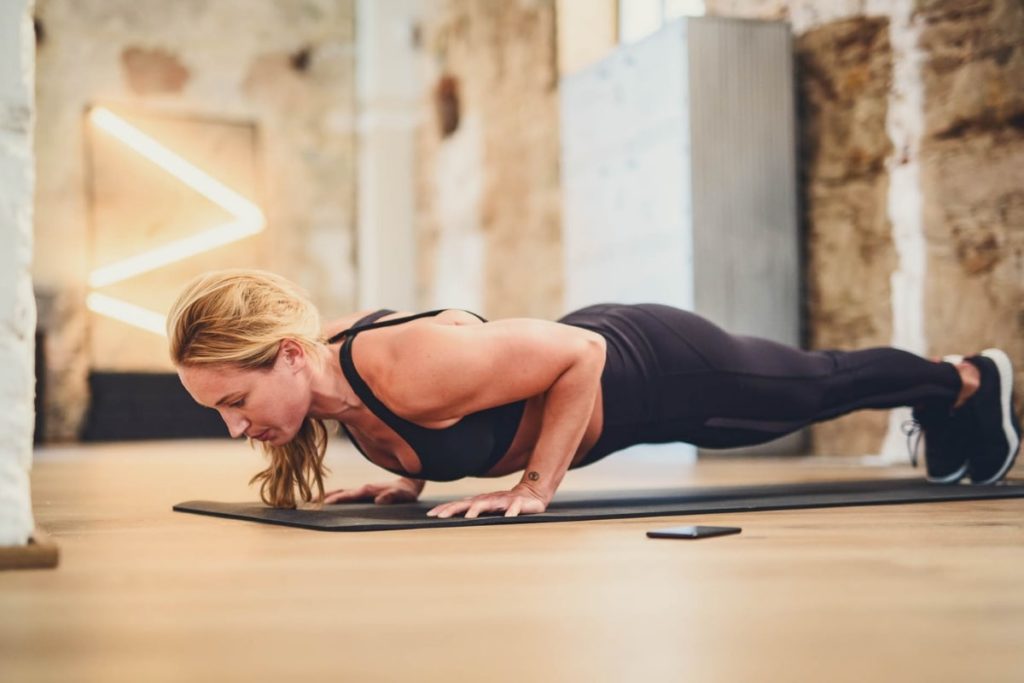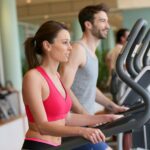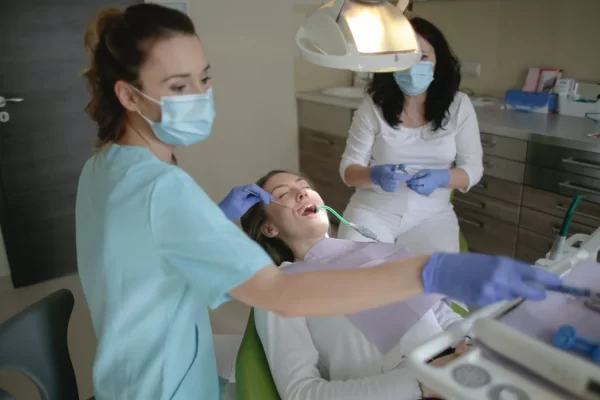Table of Contents
Are you doing cardio? You must be familiar with pushups. Or are you? Do you want to know what muscles do push ups work? Push up is a calisthenics exercise. It begins from a prone position. Calisthenics or calisthenics involve working the large muscles of the body. It focuses on gross motor movements.
They include running, climbing, standing, or pushing. Pushups consist of raising and lowering the body. Consequently, pushups exercise mainly the triceps, pectoral muscles, and anterior deltoids. Besides, the coracobrachialis, serratus anterior, and the whole of the midsection work out.
Pushups are basic exercises to improve your physique. It is used in athletics training, civilian training, or military training. Similarly, it serves as punishment in martial arts, school sports, and the military. Pushups strengthen and tone muscles of the upper body and core. Variations of pushups are available. People can do any push up to meet their individual needs. In this article, we will discuss about what muscles do push ups work, the types of workouts and their benefits.
Pushups – what muscles do push ups work ?
The muscles in the upper body are the focus of pushups. Now the question is, what muscles do push ups work? The following muscle groups are the focus of push-ups.
- Chest muscle group- including the pectoralis minor and pectoralis major.
- Back muscles- upper and middle muscles. It includes rhomboids, latissimus dorsi, and trapeze muscles.
- Shoulder muscle group- including the deltoid minor and deltoid major.
- Back of the upper arm-triceps
- Front of the upper arm- biceps
- Serratus anterior- sitting on the side of the chest. It is present below the upper arm.
Other muscles are required to do push-ups. They keep the body in a rigid plank position during push-ups. They are, namely, lower back muscles, buttocks muscles, abdominal muscles, and leg muscles. The buttocks muscles include the gluteus Maximus and medius. At the same time, the leg muscles have quadriceps, calf and shin muscles, and hamstrings.
How to perform a push up with ease?
There are a lot of muscles that develops with pushups. So if you are looking for what muscles do push ups work, we will share facts with you. A traditional push up requires you to be on the floor on a mat. Now bring the feet together behind you. Bend to go into a plank position. It will be a high plank in this case. The hands will be a shoulder-width apart. The palms must be sturdy on the floor. The fingers must be facing forward and turned in slightly. The feet must be together.
The back must be flat. Keep the core engaged. This ensures better results at getting the abs muscles. Slowly lower the body on the floor. Keep maintaining a rigid torso. The head must be aligned with the spine throughout. The back must not sag. Neither should the hips spike upwards here. Keep lowering your body until the chest and chin touches the ground. The elbows may flare outwards here.
Press the arms to move back upwards. Continue until the arms are fully extended back. On reaching the original position, keep repeating the same. Ten repetitions of 3 sets are best for any person.
How to keep a proper form?
Knowing what muscles do push ups work will not be enough and work effectively if you don’t know the proper form. To keep the form on point, follow the steps. First, keep your back straight and engaged. Second, the butt must be facing downwards. Make sure it does not spike up in the process. Third, the body must form a straight line throughout. Arching back or sagging down will cause serious injury to the back. Lastly, start on the knees before doing a standard push-up.
Types of push-ups
Here are the types of push-ups that you need to know if ou are planning to make muscle and looking for what muscles do push ups work.
Wall push-ups
Wall push-ups are suitable for beginners. It is also ideal for people with a shoulder injury. It helps to build chest muscles and shoulder muscles. However, the load on the muscles is comparatively less. This makes wall us ups suitable for injured people.
Arm, shoulders, and chest muscles are the focus of this pushup. Stand in front of the wall. The distance from the wall must be one arm’s length. Lift your hands to the shoulder length. Place the hands on the wall. The hands must be complete and shoulder apart.
Inhale. Now bend the elbows consequently. Lower the body towards the wall. Squeeze in the core and buttocks muscles while inhaling. This ensures a firm straight position while lowering the body. Now pause for a second. Next, push yourself away from the wall. The hands are remaining on the wall.
Throughout, the feet must remain flat on the floor. The heels might come off the floor. In such a situation, move closer to the wall. Three sets of 10 repetitions are best for beginners. Do not forget to take short breaks between the sets.
Standard push-ups
The key to any proper push up is the form. The varieties may be easy to execute. This the reason why the basic push-up form is underestimated. A stand push up works the chest muscles. It includes the pectoralis major and pectoralis minor, respectively. It also works the arms, shoulders, and serratus anterior.
Start by putting your weight on all four. Begin by being in a plank position. The pelvis muscles must be tucked in. The neck must be neutral. Keep this in mind to avoid neck sprain. The palms must be directly under the shoulders. The shoulders must be rotated back and downwards. All these help your position to remain intact.
Keeping the core and pelvis engaged, slowly begin to lower the body. Simultaneously, bend your elbows, pointing slightly backward. Lower down your body until it almost touches the floor. Immediately start pushing your back to the initial position. Keep repeating at your pace. Repeat the same for up to three sets.
Modified push-ups
A person may not be able to master the standard pushup. Here, modified push-ups can help. The focus of this variation is the chest muscles.
Start on all fours. The neck must be neutral to avoid injuries. Move your hands forward. Keep doing so until the back is straight—a straight-line from behind the shoulder and knees. The arms, too, must be straight.
Start on all fours. The neck must be neutral to avoid injuries. Move your hands forward. Keep doing so until the back is straight—a straight-line from behind the shoulder and knees. The arms, too, must be straight.
Keeping the elbows slightly back, bend your elbows. Now lower the whole body. Do so until the upper arms are parallel with the ground. The core and pelvis must be engaged at this point. On reaching the parallel, push up through the palms. This will extend the elbow. You are now pushing back to the initial position. Three sets of 10 repetitions are enough for any beginner.
Wide pushups
The wide push-ups are a slight modification of the standard push up. It essentially involves widening the space between the hands. This puts more pressure on the chest muscles. Besides, the muscles of the chest and shoulders are working here.
First, begin by being in a plank position. Now widen your hands by an inch or two. Make sure to find the comfortable width of the hands. Just like a standard push up, lower your body. Make sure to engage the core and pelvic muscles. Indeed, the glute muscles must be tightened to keep the position intact. Here, the elbows point further out towards the sides when the arm bends.
Again, three sets of 10 repetitions are appropriate to begin with. This is one of the most recommended workout as you search for what muscles do push ups work.
Narrow pushups
A narrow push up is another variation of a standard pushup. It has a medium to a high difficulty level. The distance between the hand positions need to be reduced; this creates more stress on the arms. Now the arms need to work harder. The focus muscles are that of the chest and triceps.
Start by putting your hands on the floor. The hands must be immediately under the chest. It must be narrower than shoulder-width apart. Begin to lower your body. Bend the elbows in sequence with the body. Keep the core muscles engaged. Now tuck in the elbows towards the chest as you bend. Stay in that position for a second.
Now lift slowly back to the starting position. Keep repeating 10 to 12 times per set. You can do up to three sets or more if you want. Narrow push-ups increase the activation of the triceps and pectoralis major. This is comparatively more than the wide push up or standard push up.
Elevated push-up
The elevated push-ups are of two types- inclined and declined pushups. It is quite a problematic variation. It is suitable for masters or pros in the field of exercise. This push up involves raising the feet above the body. It works for the shoulders, triceps, and upper hands. Feet elevated pushups have a more lasting effect on the body. Decline pushups are a lot harder than incline pushups.
Decline push up
The muscles of focus are the chest, shoulder, upper back, and triceps. Moving the feet above the ground creates a challenge. Place your legs on to some elevated
The muscles of focus are the chest, shoulder, upper back, and triceps. Moving the feet above the ground creates a challenge. Place your legs on to some elevated seat or bench. Start in a plank position. The feet must be on some sturdy, non-slippery object.
Starting in a plank position, the hands must be under your shoulder. Now lower the body. Bend your elbows slowly and gradually. Do not hasten the process. This might cause serious injury. Tighten the core. Keep the back flattened. Do this until the chest just touches the floor.
The elbows must be pointing slightly back. Pause for a second. Now pull yourself back in the original position. Repeat five times per set. You may even go at your pace. Remember to be safe and steady throughout.
Incline push up
It is an elevated form of a traditional push-up. The upper portion is elevated onto a bench or seat. This position primarily works on the chest muscles.
To begin, stand in front of the inclined object. Now squat down or bend. Place both hands with fingers pointing upwards on the object. To elevate yourself properly, use a wider object. Now you are placing your hands in the right position. Return to the inclined plank positions.
The glute, pelvic, and core muscles must be intact. Engage as much as you can. Inhale and bend straight towards the bench or object. The elbows will be bent, pointing outwards and upwards. Make sure the body is aligned with the spine. Any extra bend will cause serious injury to the spine. Keep repeating ten times for each set. Do three sets as usual.
Plyometric
A plyometric is an advanced form of push up. It is best for those who have good upper body strength. The focus here is on the chest. Keep your hands directly under the shoulders. Pelvis and core must be engaged. The neck should be relaxing but straight.
Bend with your full body. Keep the spine inclined straight with the rest of the body. Make sure elbows are pointing outwards when they are bent. Stay in that position for some time.
Now come back up with extending the elbows. Push the body back up. Instead of landing the hands, launch the upper body up with force. This will allow the body to jump back to the stretched position. The palms in this position will be off the ground. It will enable the body to bounce on with every push.
Lower your body slowly so that you do not hurt. Lower the chest again to begin another rep. Repeat for three sets.
Clap push up
Clap push-ups are a modified version of plyometrics. It is one of the most demanding push-ups for challengers. Chest, arms, and shoulder is the focus of this push-up type.
The hands are slightly wider than the shoulders. However, it is not as wide as a widened pushup. Breathe in. Engage the core muscles and the buttocks muscles. Now keep bending the elbows to move closer to the floor. Go as close as you can. Next, push back to the previous position.
Push back your body forcefully upwards. Straighten the hands and them off the floor. This will help you bring the hands together to clap once after the clap. Hands must land on the floor safely. This push up requires a lot of strength. However, the person can gain endurance over time with practice.
Rest as much as you can before each repetition. A maximum of 5 to 10 repetitions per set is enough for a person. Make sure you have enough strength before attempting this push-up.
Pike push-ups
Pike push-ups are demanding as well. It puts more weight on the triceps and shoulders: shoulders, triceps, serratus anterior, and upper back. Put yourself in a plank position. The hands must be shoulder-width apart. The heels must be off the floor, and the head must be lifted. The buttocks must be lifted from the air. Next, keep the arms straight and bending the hips to form a V shape.
While engaging the core and buttocks muscles, breathe in. the bending of the elbows will allow you to lower your head. Let the head gently touch the floor. Now breathe out slowly. Next, push the arms straight to raise the head. Simultaneously, put your shoulders back to the starting off.
Something like a yoga block may help. This is best if the person is unable to touch the floor with their head. For the beginning, start with five repetitions. Gradually increase the repetitions to 10. Two to three sets of this pushup are enough to create the physique you want.
Rolling push-ups
Take traditional push-ups to the next level. Perform a standard push up. Now by lifting your left arm, move to a side plank position. Now continue rolling. Place a hand on the ground. This will help you to do a reverse plank. By lifting your arm again, move to the next side plank position. Begin again with triceps pushup. Now go in another direction.
Five to ten repetitions per set are quite a deal for beginning this challenge. Concentrate the energy on the arms and shoulders. Engage the core and pelvis. Buttocks muscles must tighten. The hips must be lifted throughout. Make sure all the movements are getting equal attention and form. Remember, the form is the key to pushups.
Push-ups with hip abduction
Like any other push up, begin in a plank position. The arms must be slightly wider than the shoulders. The legs must be lifted off the floor. Move the legs slightly outwards from the hips. Make sure the hips lift throughout the exercise. Now do a pushup, lifting the left leg off the ground.
Now perform 5 to 8 repetitions on the same leg. Let’s switch legs now. Put down your left leg. Raise the right leg to perform a few more reps on the other leg. Try to maintain your form as much as you can throughout.
Thus the above list shows you in detail about what muscles do push ups work. Now let’s talk about other benefits.
What can be the benefits of doing pushups every day?
A traditional push up helps to build upper body strength. What muscles do push ups work also varies among genders. Now, the benefits of push-ups for males are fast and effective strength-building. As a result, triceps, shoulders, and pectoral muscles are under work. The form is the key to any pushup. A well dines push up with form increases core strength. The engagement of the abdominal muscles can do it. Similarly, the lower back strengthens in the process.
Push-ups can be done with or without any equipment. Doing a minimum of three sets of 10 repetitions is useful for any person. This is suitable if the person is trying to find a consistent routine. Eventually, again in the strength of the upper body will be noticeable.
Master the basic standard pushup. Now you can add a variation or two to your workout routine. Push up challenges can also be useful. Do challenges increase the number of push-ups every day? A person can do up to 10 repetitions in two months.
Risks of doing push-ups every day
A guaranteed risk of doing push-ups every day is plateauing. The body will no longer feel challenged anymore. This may cause plateauing trouble. In this situation, the body no longer benefits from this particular exercise. This is because the muscles adapt to the body changes over time. This improves the functioning of the muscles. It is essential to enhance body strength and fitness level.
Doing the push-ups without the correct form can cause serious injury. An injured back, shoulders, or spine is a common mistake. One must, thus, focus on the quality of the exercise done. After mastering the form, quantity can be the focus of an individual.
Do not jump into variations at first. For beginners, wall pushups are the best. Try to know the basics. Strengthen your ability to do the basics first. Then you can modify exercises as much as you want. A former injury on the wrist or shoulder blades may cause risk. Make sure to consult the doctor before doing any push-ups. Doctors may recommend the dolphin push-ups or the knuckle push-ups in that case.
Concluding.
So we have discussed everything on What muscles do push ups work, their benefits and the process of doing. Push-ups are a great way to increase body strength. Keeping the core engaged helps you to reach the form you want. Make sure the body is sturdy before doing a push-up. Make sure you accommodate at least two sets of any variation. Working out daily will give you the fastest results.
Frequently Asked Questions
Q1: Which muscles are primarily targeted during push-ups?
A1: Push-ups primarily work the chest (pectoralis major).
Q2: What other muscle groups are involved in push-ups?
A2: Push-ups also engage the shoulders (deltoids) and triceps.
Q3: Do push-ups help strengthen the core muscles?
A3: Yes, push-ups engage the core muscles, including the abdominals and lower back.
Q4: Are there any other secondary muscles involved in push-ups?
A4: The push-up exercise also activates the muscles in the arms, such as the biceps and forearms.
Q5: Can push-ups be beneficial for overall upper body strength?
A5: Absolutely! Push-ups are an effective compound exercise that can help improve strength in the chest, shoulders, triceps, and core muscles.











